In the heart of Chanthaburi Province, Thailand, a quiet revolution is taking place in the durian orchards of the Royal Initiatives Project. Researchers, led by Pattharaporn Thongnim from the Department of Mathematics at Burapha University, are harnessing the power of the Internet of Things (IoT) and chatbot technology to transform traditional durian farming into a precision agriculture powerhouse. Their work, published in ‘Discover Internet of Things’, offers a glimpse into the future of sustainable and efficient farming practices.
The research introduces a chatbot that acts as a digital agricultural assistant, bridging the gap between farmers and IoT systems. This innovative tool doesn’t just monitor environmental conditions; it actively controls irrigation and provides tailored advice based on the developmental stages of the durian fruit. “The chatbot calculates daily water requirements using data from environmental sensors,” explains Thongnim. “It then offers irrigation recommendations, ensuring that each durian tree receives the precise amount of water it needs.”
The implications for the agriculture sector are profound. Precision agriculture, as demonstrated in this study, can significantly enhance resource efficiency. The research found that precise irrigation, guided by the chatbot, resulted in a remarkable 21.65% reduction in water usage compared to traditional farming methods. This is a game-changer in an industry where water scarcity and sustainability are growing concerns.
Moreover, the chatbot integrates data from various sources, including government services like weather reports and agricultural irrigation information, to support production planning. This holistic approach not only optimizes water usage but also enhances overall farm management. “The chatbot serves as a communication intermediary, offering precise irrigation control and consultation,” Thongnim adds. This level of integration and automation can lead to increased productivity, reduced costs, and improved crop quality.
The study focused on 9–10 year old durian trees, and the results were promising. Durians produced with precise irrigation showed no significant quality difference compared to those grown using traditional methods. This finding underscores the potential of data-driven agriculture to maintain high standards while improving efficiency.
Looking ahead, this research could shape the future of farming in several ways. Firstly, it highlights the potential of IoT and chatbot technology to revolutionize agricultural practices. As these technologies become more accessible, farmers worldwide could benefit from similar precision agriculture tools. Secondly, the study demonstrates the importance of data integration in farming. By combining data from various sources, farmers can make more informed decisions, leading to better resource management and increased productivity.
In the broader context, this research could pave the way for more sustainable and efficient farming practices. As the global population grows, the demand for food will increase, and traditional farming methods may struggle to keep up. Precision agriculture, as exemplified by this study, offers a viable solution. By optimizing resource usage and enhancing productivity, it can help meet the world’s food demands while minimizing environmental impact.
In conclusion, the work of Thongnim and her team represents a significant step forward in the field of precision agriculture. Their innovative use of IoT and chatbot technology offers a blueprint for the future of farming, one that is more efficient, sustainable, and data-driven. As these technologies continue to evolve, they could transform the agriculture sector, benefiting farmers, consumers, and the environment alike.

